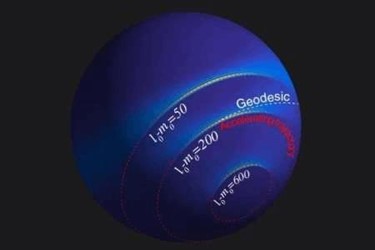First Observation Of Accelerating Beams In Curved Space
By Jof Enriquez,
Follow me on Twitter @jofenriq

Physicists report the first experimental observation of accelerating light beams in curved space. This phenomenon provides new ideas for emulating Einstein's general relativity, as well as new ways of propagating light in curved surfaces and media.
In simplest terms, light can be described as rays traveling from one point to another in a straight line. But because light is actually a wave, it can propagate in a self-accelerating manner. Previous experiments have shown that accelerating light beams on flat surfaces can follow curved trajectories, rather than straight lines.
Physicists Anatoly Patsyk, Miguel A. Bandres, and Mordechai Segev at the Technion – Israel Institute of Technology, along with Rivka Bekenstein at Harvard University and the Harvard-Smithsonian Center for Astrophysics, took this one step further to discover if accelerating light beams also propagate on curved surfaces.
According to Futurism, the team first reflected a laser off a spatial light modulator, which is a device used to modulate amplitude, phase, or polarize light waves. Bouncing the beam off this device imprints a specific wavefront on the beam, creating one that accelerates while keeping its shape.
The researchers already know that light beams directed to travel on the surface of a sphere move along geodesic paths, the largest circle on the sphere’s surface. In their new experiment, however, they found out that the specifically shaped beam they bounced off the spatial light modulator and along the inside of the red shell of an incandescent light bulb, bended away from the shortest (geodesic) path as a result of its acceleration. Instead of following the expected path, the light beam is observed to continue to accelerate and evolve in a shape-preserving manner on a nongeodesic trajectory.
"Unlike accelerating beams in flat space, these wave packets change their acceleration trajectory due to the interplay between interference effects and the space curvature, and they focus and defocus periodically due to the spatial curvature of the medium in which they propagate," the scientists wrote in Physical Review X.
This new capability to accelerate light beams along curved surfaces raises the potential to study phenomena like gravitational lensing, which originate from Einstein's general theory of relativity.
"Einstein's equations of general relativity determine, among other issues, the evolution of electromagnetic waves in curved space," Patsyk told Phys.org. "It turns out that the evolution of electromagnetic waves in curved space according to Einstein's equations is equivalent to the propagation of electromagnetic waves in a material medium described by the electric and magnetic susceptibilities that are allowed to vary in space. This is the foundation of emulating numerous phenomena known from general relativity by the electromagnetic waves propagating in a material medium, giving rise to the emulating effects such as gravitational lensing and Einstein's rings, gravitational blue shift or red shift, which we have studied in the past, and much more."
Other practical applications of propagating light along curved surfaces include guiding nanoparticles in blood vessels and accelerating plasmonic beams to transfer power from one area to another on a curved surface.
